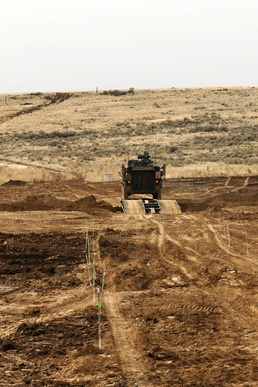
YAKIMA TRAINING CENTER, Wash. – For the first time since the brigade’s deployment to Iraq from 2009-2010, the Mobility Support Platoon of the 38th Engineer Company successfully launched the Rapidly Emplaced Bridge System in a tactical environment Feb. 14 here.
The company’s REBS provide the 4th Stryker Brigade Combat Team, 2nd Infantry Division “Raiders” with a tactical bridging capability, assuring mobility across gaps of more than 40 feet. The system is composed of the bridge itself and its carrier vehicle, the M1977 Common Bridge Transporter.
Bringing the complex system to full combat readiness began months before the demonstration during Exercise Raider Focus, a month-long brigade training exercise.
“At the beginning of December, we were able to secure training at [Joint Base Lewis-McChord, Wash.] for our ‘12-Charlies’, our bridgers, to attend,” said 1st Lt. Philip Cotter, MSP platoon leader.
The two weeks of training focused on the fundamental “bread and butter” skills of proper maintenance, site selection and REBS launch and retrieval.
According to Cotter, the training enabled the Soldiers to “come into their own,” as they went from a minimal amount of expertise on the system to being proficient in emplacing them tactically and to standard.
At the Engineer Dig Site here, the conditions for one of the unit’s Mission Essential Tasks were set: overcoming an enemy anti-tank ditch dug to obstruct the brigade’s mobility.
Capt. Jefferson D. Mason, 38th Eng. Co. commander, provided narration to the observers of the action occurring on a field churned to mud by the wheels of heavy vehicles.
The scenario began with vehicles waiting in concealed positions. The staccato sound of a pneumatic machine gun simulated the suppression of a notional enemy on the objective, as Strykers moved into position to secure the near side of the crossing site.
The CBT vehicle emerged from concealment and made a three-point turn, backing up to the crossing point to emplace the REBS. The doors opened, starting the clock, and two bridge crewmen dismounted.
“Now begins the longest 12 minutes of any sapper engineer’s life: establishment of the gap crossing,” announced Mason.
The soldiers of the MSP performed the 26 steps necessary to launch the REBS. With its hydraulic system activated, the bridge unlocked from the chassis of the truck and began to extend.
Emplacement wrapped up in 11 minutes and 15 seconds, under the 12-minute standard set for the battle drill, and a second element of Strykers crossed the newly-laid bridge to provide far-side security.
With the bridge in place and security established, follow-on assault forces could move through a safe corridor designated by a Lane Marking System, for a final push to the objective.
According to Cotter, the exercise unfolded as planned.
“The first time we launched REBS, it probably took 25-30 minutes to get it off the truck onto the ground,” he said. “The [soldiers] rehearsed at night, in the cold and wind, and now we see the end result. It really says a lot about their motivation.”
“The guys are awesome; it’s a blast being out here,” said Cotter, “If we’re not covered in dirt, we’re not doing our job.”